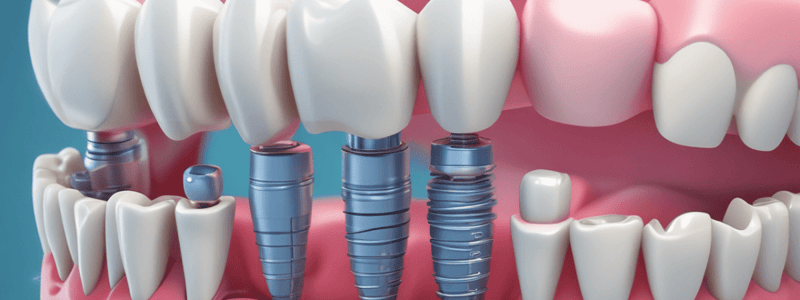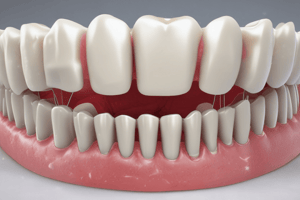Podcast
Questions and Answers
What is a common cause of denture-related problems?
What is a common cause of denture-related problems?
- Jaw misalignment
- Gum disease
- Alveolar ridge resorption (correct)
- Tooth decay
What might need to be done for a patient with severe alveolar ridge resorption according to the text?
What might need to be done for a patient with severe alveolar ridge resorption according to the text?
- Undergo major surgery involving rib removal and mandible reconstruction (correct)
- Receive dentures with better grip
- Get immediate dental implants
- Regular dental check-ups
How does peri-implantitis affect implant stability according to the text?
How does peri-implantitis affect implant stability according to the text?
- It increases implant stability
- It has no impact on implant stability
- It stabilizes the implant
- It decreases implant stability over time (correct)
What type of implant restoration does the text suggest is not commonly performed?
What type of implant restoration does the text suggest is not commonly performed?
For a patient with severe alveolar ridge resorption, why are implants not a likely solution according to the text?
For a patient with severe alveolar ridge resorption, why are implants not a likely solution according to the text?
What is the primary purpose of using a titanium brush on a dental implant surface?
What is the primary purpose of using a titanium brush on a dental implant surface?
What is a key challenge when treating peri-implantitis?
What is a key challenge when treating peri-implantitis?
What is a key step that must be taken before attempting any bone grafting or restorative procedures for peri-implantitis?
What is a key step that must be taken before attempting any bone grafting or restorative procedures for peri-implantitis?
What does the text suggest about the effectiveness of different treatment approaches for peri-implantitis?
What does the text suggest about the effectiveness of different treatment approaches for peri-implantitis?
What is the significance of the statement in the text that 'None of it works 100%'?
What is the significance of the statement in the text that 'None of it works 100%'?
What is the consequence of exposing the implant surface to air for too long?
What is the consequence of exposing the implant surface to air for too long?
How long is the window of time between opening the sealed vial and inserting the implant into the osteotomy?
How long is the window of time between opening the sealed vial and inserting the implant into the osteotomy?
What distinguishes the SLA Active implant surface from the SLA implant?
What distinguishes the SLA Active implant surface from the SLA implant?
What is a common objective of modifying implant surfaces by different companies?
What is a common objective of modifying implant surfaces by different companies?
Which factor contributes to the limited time available to work with the implant after opening the sealed vial?
Which factor contributes to the limited time available to work with the implant after opening the sealed vial?
Which of the following is NOT a method mentioned for detoxifying the implant surface in cases of peri-implantitis?
Which of the following is NOT a method mentioned for detoxifying the implant surface in cases of peri-implantitis?
What is the primary reason for using a lot of water during the process of detoxifying the implant surface?
What is the primary reason for using a lot of water during the process of detoxifying the implant surface?
What is the primary cause of the need for detoxifying the implant surface?
What is the primary cause of the need for detoxifying the implant surface?
Which of the following substances is NOT mentioned in the text as a possible agent for detoxifying the implant surface?
Which of the following substances is NOT mentioned in the text as a possible agent for detoxifying the implant surface?
Based on the information provided, what percentage of patients with Perry implant Titus are considered 'unfortunate'?
Based on the information provided, what percentage of patients with Perry implant Titus are considered 'unfortunate'?
What should be the first question to consider when faced with an edentulous area or an area that will become edentulous?
What should be the first question to consider when faced with an edentulous area or an area that will become edentulous?
What is a major consideration when determining the suitability of placing a dental implant in an edentulous area according to the text?
What is a major consideration when determining the suitability of placing a dental implant in an edentulous area according to the text?
Which dental treatment option is suggested as being potentially unstable in the text?
Which dental treatment option is suggested as being potentially unstable in the text?
In the context provided, what is implied to be a potential consequence of leaving an edentulous area untreated?
In the context provided, what is implied to be a potential consequence of leaving an edentulous area untreated?
What type of denture was suggested as an option in the scenario described that involves extracting most of the teeth?
What type of denture was suggested as an option in the scenario described that involves extracting most of the teeth?
What is the primary purpose of using a titanium brush on the implant surface during treatment of peri-implantitis?
What is the primary purpose of using a titanium brush on the implant surface during treatment of peri-implantitis?
Which of the following agents is NOT mentioned in the text for cleaning the implant surface after debridement?
Which of the following agents is NOT mentioned in the text for cleaning the implant surface after debridement?
What is the potential benefit of using minocycline during the surgical procedure?
What is the potential benefit of using minocycline during the surgical procedure?
What is the purpose of decorating (decortication) the buccal plate during the surgical procedure?
What is the purpose of decorating (decortication) the buccal plate during the surgical procedure?
What is the speaker's opinion regarding the use of a high-speed handpiece for implant surface debridement?
What is the speaker's opinion regarding the use of a high-speed handpiece for implant surface debridement?
What was the primary concern that led the patient to seek a second opinion?
What was the primary concern that led the patient to seek a second opinion?
What was the alternative treatment approach recommended by the speaker?
What was the alternative treatment approach recommended by the speaker?
Based on the information provided, what can be inferred about the patient's financial situation?
Based on the information provided, what can be inferred about the patient's financial situation?
Which statement accurately reflects the speaker's perspective on the choice of attachment system used in the implant restoration?
Which statement accurately reflects the speaker's perspective on the choice of attachment system used in the implant restoration?
Based on the information provided, what can be inferred about the speaker's area of expertise?
Based on the information provided, what can be inferred about the speaker's area of expertise?
Based on the information provided, what can be inferred about the patient's remaining dentition?
Based on the information provided, what can be inferred about the patient's remaining dentition?
Which statement accurately reflects the potential impact of alveolar ridge resorption on treatment planning?
Which statement accurately reflects the potential impact of alveolar ridge resorption on treatment planning?
What can be inferred about the potential risk of peri-implantitis in the patient's case?
What can be inferred about the potential risk of peri-implantitis in the patient's case?
Which statement accurately reflects the potential advantages of the implant-supported removable partial denture approach chosen for this patient?
Which statement accurately reflects the potential advantages of the implant-supported removable partial denture approach chosen for this patient?
What can be inferred about the potential need for future treatment or maintenance for this patient?
What can be inferred about the potential need for future treatment or maintenance for this patient?
Flashcards are hidden until you start studying
Study Notes
Treatment Options for Edentulous Areas
- The first question to consider when treating an edentulous area is why not a dental implant, considering factors such as medical history, bone amount, and other teeth.
- Implants may be the best option depending on the circumstances, and it's essential to rule out implant placement before considering other alternatives.
Partial Dentures
- A partial denture may be an option, but its stability may be questionable, especially if it relies on clasps.
- Even with clasps, the stability of a partial denture may not be sufficient.
Implant-Supported Overdentures
- An implant-supported overdenture is an option, involving extracting all remaining teeth except for the implants.
- This option is not a natural tooth-supported overdenture.
Treatment of Peri-Implantitis
- Peri-implantitis is a condition where bone loss occurs around a dental implant, and detoxifying the implant surface is necessary.
- Methods for detoxifying the implant surface include:
- Plasti surgery: using a high-speed bar to remove roughened surfaces and exposed threads, while generating a lot of heat and titanium particles.
- Powder abrasion
- Ultrasonics
- Non-metal curates
- Citric acid
- Chlorhexidine
- EDTA
- The effectiveness of these methods varies, and there is no clear evidence of which one is superior.
Restoration Options
- The choice of restoration option can have consequences, and it's essential to consider these consequences.
- Common causes of denture-related problems include alveolar ridge resorption, which can be difficult to treat.
Detoxifying the Implant Surface
- Detoxifying the implant surface is crucial before placing a bone graft or treating the defect.
- A titanium brush can be used to clean the implant surface, removing toxins and poisons.
Implant Surface Modification
- Companies like Strom and Nobel Biocare are working on modifying implant surfaces to make them more biocompatible and effective.
- These modifications can improve the stability of the implant, with some getting similar results in a shorter time.
Detoxification and Bone Grafting
- Detoxifying the implant surface can be done using various methods, including titanium brushes, saline, tetracycline, and EDTA.
- After detoxification, a bone graft can be placed to promote additional bone growth.
Real-World Case Study
- A patient came in for a second opinion after being recommended to extract all their remaining teeth and get a denture.
- The patient was given an alternative option of placing two implants, which didn't take long and provided a stable solution.
Studying That Suits You
Use AI to generate personalized quizzes and flashcards to suit your learning preferences.




